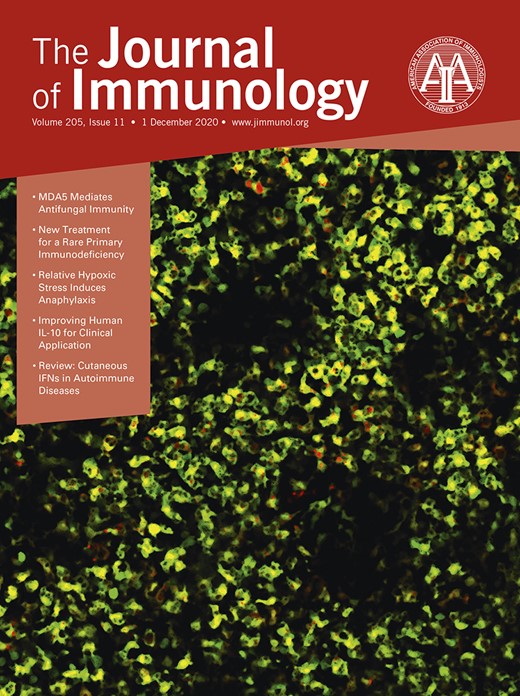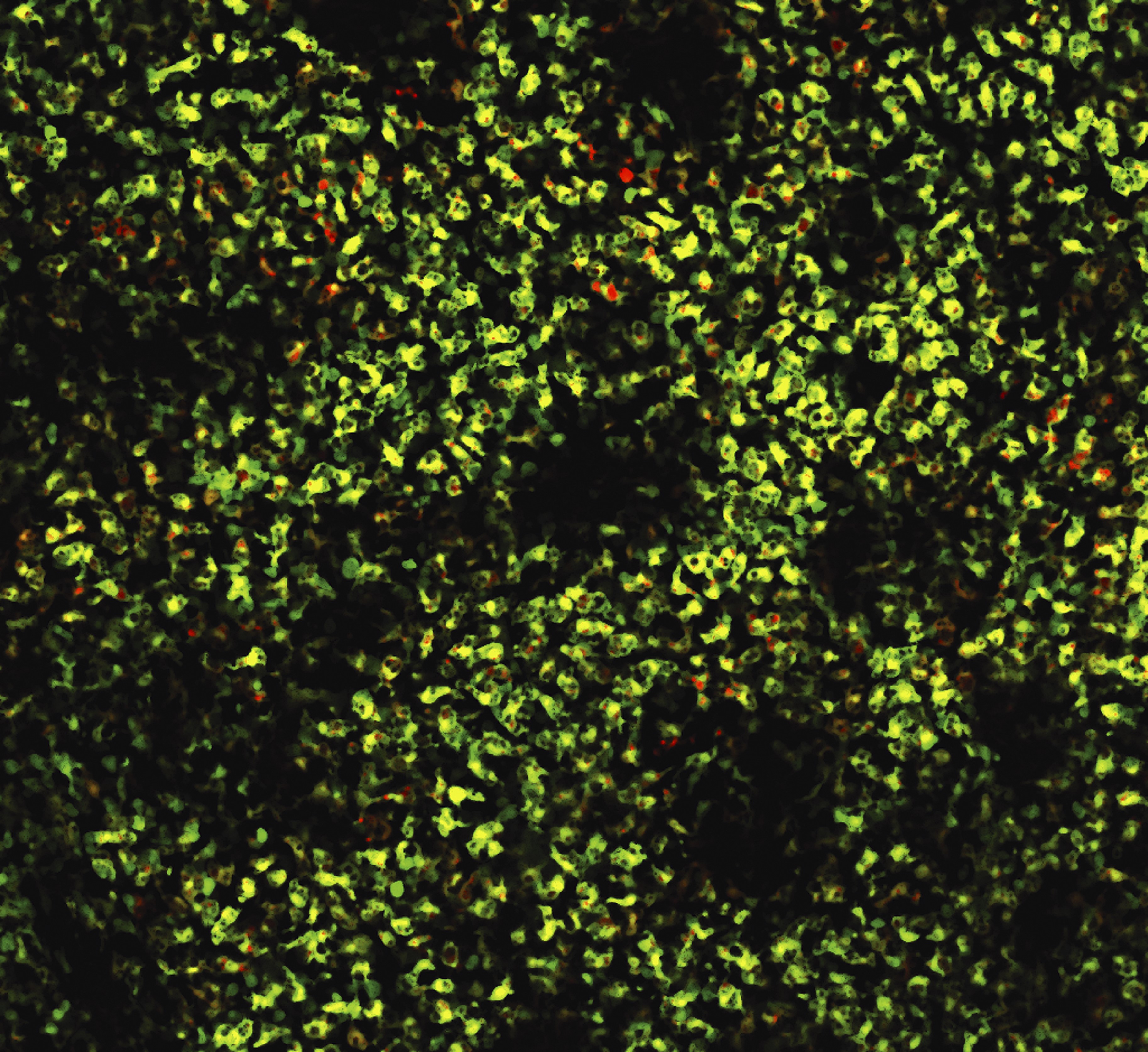
Cover image

On the cover: Whole mount confocal imaging of spleen of CSF1R-FRed × Csf1r-EGFP mice showing complete overlap of FusionRed with EGFP, supporting the utility of the CSF1R-FRed transgenic marker. Grabert, K., A. Sehgal, K. M. Irvine, E. Wollscheid-Lengeling, D. D. Ozdemir, J. Stables, G. A. Luke, M. D. Ryan, A. Adamson, N. E. Humphreys, C. J. Sandrock, R. Rojo, V. A. Verkasalo, W. Mueller, P. Hohenstein, A. R. Pettit, C. Pridans, and D. A. Hume. 2020. A transgenic line that reports CSF1R protein expression provides a definitive marker for the mouse mononuclear phagocyte system. J. Immunol. 205: 3154–3166.
Volume 205, Issue 11, December 2020
Top Reads
Top Reads
Brief Reviews
The Role of Cutaneous Type I IFNs in Autoimmune and Autoinflammatory Diseases
Cutting Edge
Cutting Edge: CRISPR-Based Transcriptional Regulators Reveal Transcription-Dependent Establishment of Epigenetic Memory of Foxp3 in Regulatory T Cells
CRISPR/dCas9–based transcriptional activation of Foxp3 promotes CNS2 demethylation.
Sustaining Foxp3-transcriptional activation in iTregs promotes CNS2 demethylation.
CRISPR inhibition of Foxp3 transcription abolishes CNS2 demethylation in iTregs.
Allergy and Other Hypersensitivities
A Rapid Shift from Chronic Hyperoxia to Normoxia Induces Systemic Anaphylaxis via Transient Receptor Potential Ankyrin 1 Channels on Mast Cells
Rapid reductions in oxygen tension triggered the degranulation of mast cells.
Oxygen-induced activation of mast cells was mediated via TRPA1 channels.
Rapid reductions in oxygen tension induced anaphylactic shock.
Clinical and Human Immunology
IL-7Rαlow CD8+ T Cells from Healthy Individuals Are Anergic with Defective Glycolysis
IL-7Rαlow EM CD8+ T cells are anergy-like cells in vivo.
IL-7Rαlow EM CD8+ T cells are defective in aerobic glycolysis.
Seletalisib for Activated PI3Kδ Syndromes: Open-Label Phase 1b and Extension Studies
Seletalisib, a PI3Kδ inhibitor, was evaluated in seven patients with APDS1 and APDS2.
Following treatment, patients had improvements in clinical and immunological features.
Seletalisib had a favorable risk–benefit profile in a phase 1b study up to 96 wk.
Immune Regulation
Interorganelle Tethering to Endocytic Organelles Determines Directional Cytokine Transport in CD4+ T Cells
CytVs tether with lysosomes in T cells.
Lysosome-tethered CytVs are preferentially transported to their desired destination.
Lysosome tethering can mediate directionally distinctive CytV transport.
Voltage-Gated Proton Channel Hv1 Controls TLR9 Activation in Plasmacytoid Dendritic Cells
Hv1 is recruited to early endosomes of pDCs following their activation with CpG ODN.
In pDCs, Hv1 promotes endosomal acidification and controls excessive ROS production.
Proton delivery into endosomes by Hv1 is required for TLR9 and IFN-I responses.
AMPKα1 in B Cells Dampens Primary Antibody Responses yet Promotes Mitochondrial Homeostasis and Persistence of B Cell Memory
AMPK dampens mTORC1 activity and the synthesis of Ab in plasma cells.
AMPK promotes mitochondrial homeostasis in B lymphoblasts and memory B cells.
AMPK supports the persistence of the memory B cell population and humoral recall.
Immunotherapy and Vaccines
Vaccination with Intradermal Bacillus Calmette–Guérin Provides Robust Protection against Extrapulmonary Tuberculosis but Not Pulmonary Infection in Cynomolgus Macaques
Intradermal BCG vaccination cannot protect cynomolgus macaques against pulmonary TB.
Extrapulmonary TB is strongly controlled in intradermal BCG–vaccinated monkeys.
Infectious Disease and Host Response
IL-1α Is Essential for Oviduct Pathology during Genital Chlamydial Infection in Mice
IL-1α drives oviduct pathology during genital Chlamydia infection in mice.
IL-1α promotes neutrophil recruitment to the genital tract.
Infection increases IL-1α expression in genital tract epithelial cells.
Juvenile, but Not Adult, Mice Display Increased Myeloid Recruitment and Extracellular Matrix Remodeling during Respiratory Syncytial Virus Infection
Juvenile mice exhibit increased myeloid recruitment during RSV infection.
Recruitment and cell matrix factors were noted in juvenile, not adult, mice.
These mouse-based data are supported by findings from a human coculture system.
MDA5 Is an Essential Sensor of a Pathogen-Associated Molecular Pattern Associated with Vitality That Is Necessary for Host Resistance against Aspergillus fumigatus
MDA5 is essential for maintaining host resistance against A. fumigatus.
MDA5 serves as a critical vitality sensor after fungal challenge.
MDA5 is essential for IFN-λ expression and antifungal neutrophil killing.
Plasmodium yoelii Uses a TLR3-Dependent Pathway to Achieve Mammalian Host Parasitism
P. yoelii 265 BY liver stage triggers TLR3-dependent signaling pathways.
TLR3 KO mice better controlled liver and blood stage parasites growth.
TLR3 participates in early IFN-γ and delayed type I IFNs production.
Zika Virus–Infected Decidual Cells Elicit a Gestational Age–Dependent Innate Immune Response and Exaggerate Trophoblast Zika Permissiveness: Implication for Vertical Transmission
ZIKV permissiveness of decidual cells is gestational age dependent.
ZIKV-infected DC supernatants enhance ZIKV infection of trophoblasts.
Tizoxanide inhibits ZIKV infection of both decidual and trophoblast cells.
ESAT-6 Protein of Mycobacterium tuberculosis Increases Holotransferrin-Mediated Iron Uptake in Macrophages by Downregulating Surface Hemochromatosis Protein HFE
ESAT-6 protein interacts with β2M, causing sequestration of HFE in ER.
Sequestration of HFE in ER causes downregulation of HFE:TFR1 on macrophage surface.
This increased holotransferrin-mediated iron uptake during M. tuberculosis infection.
Pregnancy Alters Innate and Adaptive Immune Responses to Zika Virus Infection in the Reproductive Tract
Pregnancy results in recruitment of tolerogenic dendritic cells to the uterus.
Pregnancy results in lessened IL-12 responses to Zika virus infection.
Pregnant mice have fewer Ag-experienced T cells after Zika infection.
Evaluation of IL-17D in Host Immunity to Group A Streptococcus Infection
GAS infection in Il17d−/− mice leads to greater bacterial burden in kidneys.
Viable, but not heat-killed, GAS induces Il17d in nonimmune cells.
A scavenger of reactive oxygen species inhibits Il17d induction in nonimmune cells.
SARS-CoV-2 Cysteine-like Protease Antibodies Can Be Detected in Serum and Saliva of COVID-19–Seropositive Individuals
SARS-CoV-2 protease (Mpro) stimulates a strong Ab response.
Detection of Mpro Abs in serum or saliva can provide a new diagnostic tool.
Innate Immunity and Inflammation
Angiotensin II Type 2 Receptor Modulates Synovial Macrophage Polarization by Inhibiting GRK2 Membrane Translocation in a Rat Model of Collagen-Induced Arthritis
The imbalance between AT1R and AT2R could be involved in advancing RA progression.
AT2R activation supports an M2 phenotype in SMs that attenuates the course of CIA.
AT2R-caused cytoplasm GRK2/p-ERK1/2 coexpression can downregulate NF-κB activation.
A Transgenic Line That Reports CSF1R Protein Expression Provides a Definitive Marker for the Mouse Mononuclear Phagocyte System
We have inserted a FRed reporter cassette into the mouse Csf1r locus.
Expression of CSF1R-FRed is restricted to cells of the mononuclear phagocyte lineage.
CSF1R-FRed is absent from lineage-negative stem cell populations in bone marrow.
USP39 Serves as a Deubiquitinase to Stabilize STAT1 and Sustains Type I IFN–Induced Antiviral Immunity
USP39 stabilizes STAT1 protein level.
USP39 as deubiquitinase can reduce the K6-linked ubiquitination of STAT1.
USP39 can sustain type I IFN–induced antiviral immunity.
Mucosal Immunology
Exosomal miRNA-19a and miRNA-614 Induced by Air Pollutants Promote Proinflammatory M1 Macrophage Polarization via Regulation of RORα Expression in Human Respiratory Mucosal Microenvironment
Air pollutants induce miR-19a and miR-614 expression in the nasal epithelium.
Secreted exosomal miR-19a and miR-614 regulate RORα expression.
Downregulated RORα promotes proinflammatory M1 macrophage polarization.
A Novel Fusion of IL-10 Engineered to Traffic across Intestinal Epithelium to Treat Colitis
Human IL-10 genetically fused to Chx exotoxin transcytosis domain (AMT-101).
AMT-101 was tested in human cell models in vitro and in rodents and nonhuman primates in vivo.
Oral dosing targeted intestinal lamina propria to suppress inflammation without systemic PK.
Specialized Proresolving Mediators Overcome Immune Suppression Induced by Exposure to Secondhand Smoke
SPMs as adjuvants augment the efficacy of vaccination with NTHI P6 Ag in mice.
SPM-adjuvanted vaccination efficacy rescues SHS-suppressed antibacterial immunity.
Mice receiving SPM-adjuvanted vaccination rapidly clear acute infection with less lung damage.
Tumor Immunology
Complement as Prognostic Biomarker and Potential Therapeutic Target in Renal Cell Carcinoma
Complement genes are associated with poor prognosis in kidney cancer.
Complement in plasma correlates with response to immune checkpoint inhibitors.
Complement contributes to dysfunction of tumor-infiltrating T cells.


